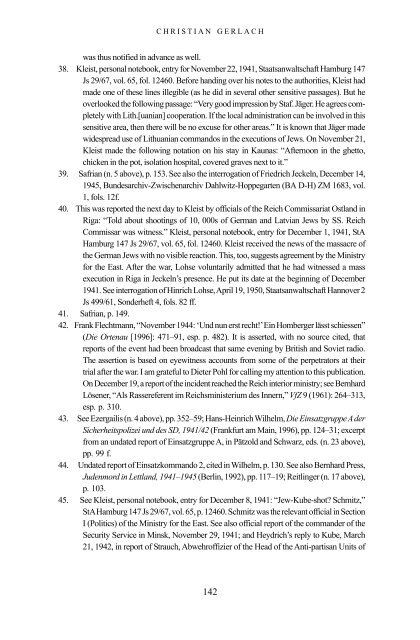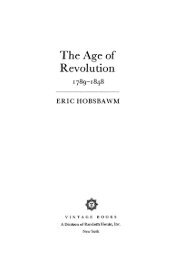The_Holokaust_-_origins,_implementation,_aftermath
The_Holokaust_-_origins,_implementation,_aftermath
The_Holokaust_-_origins,_implementation,_aftermath
Create successful ePaper yourself
Turn your PDF publications into a flip-book with our unique Google optimized e-Paper software.
CHRISTIAN GERLACH<br />
was thus notified in advance as well.<br />
38. Kleist, personal notebook, entry for November 22, 1941, Staatsanwaltschaft Hamburg 147<br />
Js 29/67, vol. 65, fol. 12460. Before handing over his notes to the authorities, Kleist had<br />
made one of these lines illegible (as he did in several other sensitive passages). But he<br />
overlooked the following passage: “Very good impression by Staf. Jäger. He agrees completely<br />
with Lith.[uanian] cooperation. If the local administration can be involved in this<br />
sensitive area, then there will be no excuse for other areas.” It is known that Jäger made<br />
widespread use of Lithuanian commandos in the executions of Jews. On November 21,<br />
Kleist made the following notation on his stay in Kaunas: “Afternoon in the ghetto,<br />
chicken in the pot, isolation hospital, covered graves next to it.”<br />
39. Safrian (n. 5 above), p. 153. See also the interrogation of Friedrich Jeckeln, December 14,<br />
1945, Bundesarchiv-Zwischenarchiv Dahlwitz-Hoppegarten (BA D-H) ZM 1683, vol.<br />
1, fols. 12f.<br />
40. This was reported the next day to Kleist by officials of the Reich Commissariat Ostland in<br />
Riga: “Told about shootings of 10, 000s of German and Latvian Jews by SS. Reich<br />
Commissar was witness.” Kleist, personal notebook, entry for December 1, 1941, StA<br />
Hamburg 147 Js 29/67, vol. 65, fol. 12460. Kleist received the news of the massacre of<br />
the German Jews with no visible reaction. This, too, suggests agreement by the Ministry<br />
for the East. After the war, Lohse voluntarily admitted that he had witnessed a mass<br />
execution in Riga in Jeckeln’s presence. He put its date at the beginning of December<br />
1941. See interrogation of Hinrich Lohse, April 19, 1950, Staatsanwaltschaft Hannover 2<br />
Js 499/61, Sonderheft 4, fols. 82 ff.<br />
41. Safrian, p. 149.<br />
42. Frank Flechtmann, “November 1944: ‘Und nun erst recht!’ Ein Homberger lässt schiessen”<br />
(Die Ortenau [1996]: 471–91, esp. p. 482). It is asserted, with no source cited, that<br />
reports of the event had been broadcast that same evening by British and Soviet radio.<br />
<strong>The</strong> assertion is based on eyewitness accounts from some of the perpetrators at their<br />
trial after the war. I am grateful to Dieter Pohl for calling my attention to this publication.<br />
On December 19, a report of the incident reached the Reich interior ministry; see Bernhard<br />
Lösener, “Als Rassereferent im Reichsministerium des Innern,” VfZ 9 (1961): 264–313,<br />
esp. p. 310.<br />
43. See Ezergailis (n. 4 above), pp. 352–59; Hans-Heinrich Wilhelm, Die Einsatzgruppe A der<br />
Sicherheitspolizei und des SD, 1941/42 (Frankfurt am Main, 1996), pp. 124–31; excerpt<br />
from an undated report of Einsatzgruppe A, in Pätzold and Schwarz, eds. (n. 23 above),<br />
pp. 99 f.<br />
44. Undated report of Einsatzkommando 2, cited in Wilhelm, p. 130. See also Bernhard Press,<br />
Judenmord in Lettland, 1941–1945 (Berlin, 1992), pp. 117–19; Reitlinger (n. 17 above),<br />
p. 103.<br />
45. See Kleist, personal notebook, entry for December 8, 1941: “Jew-Kube-shot Schmitz,”<br />
StA Hamburg 147 Js 29/67, vol. 65, p. 12460. Schmitz was the relevant official in Section<br />
I (Politics) of the Ministry for the East. See also official report of the commander of the<br />
Security Service in Minsk, November 29, 1941; and Heydrich’s reply to Kube, March<br />
21, 1942, in report of Strauch, Abwehroffizier of the Head of the Anti-partisan Units of<br />
142



